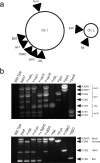Vibrio cholerae requires oxidative respiration through the bd-I and cbb3 oxidases for intestinal proliferation
- PMID: 35500027
- PMCID: PMC9109917
- DOI: 10.1371/journal.ppat.1010102
Vibrio cholerae requires oxidative respiration through the bd-I and cbb3 oxidases for intestinal proliferation
Abstract
Vibrio cholerae respires both aerobically and anaerobically and, while oxygen may be available to it during infection, other terminal electron acceptors are proposed for population expansion during infection. Unlike gastrointestinal pathogens that stimulate significant inflammation leading to elevated levels of oxygen or alternative terminal electron acceptors, V. cholerae infections are not understood to induce a notable inflammatory response. To ascertain the respiration requirements of V. cholerae during infection, we used Multiplex Genome Editing by Natural Transformation (MuGENT) to create V. cholerae strains lacking aerobic or anaerobic respiration. V. cholerae strains lacking aerobic respiration were attenuated in infant mice 105-fold relative to wild type, while strains lacking anaerobic respiration had no colonization defect, contrary to earlier work suggesting a role for anaerobic respiration during infection. Using several approaches, including one we developed for this work termed Comparative Multiplex PCR Amplicon Sequencing (CoMPAS), we determined that the bd-I and cbb3 oxidases are essential for small intestinal colonization of V. cholerae in the infant mouse. The bd-I oxidase was also determined as the primary oxidase during growth outside the host, making V. cholerae the only example of a Gram-negative bacterial pathogen in which a bd-type oxidase is the primary oxidase for energy acquisition inside and outside of a host.
Conflict of interest statement
The authors have declared that no competing interests exist.
Figures







Similar articles
-
Carbon source, cell density, and the microbial community control inhibition of V. cholerae surface colonization by environmental nitrate.mBio. 2025 Apr 9;16(4):e0406624. doi: 10.1128/mbio.04066-24. Epub 2025 Feb 25. mBio. 2025. PMID: 39998205 Free PMC article.
-
Aerobic Metabolism in Vibrio cholerae Is Required for Population Expansion during Infection.mBio. 2020 Sep 1;11(5):e01989-20. doi: 10.1128/mBio.01989-20. mBio. 2020. PMID: 32873763 Free PMC article.
-
Genetic Dissection of the Fermentative and Respiratory Contributions Supporting Vibrio cholerae Hypoxic Growth.J Bacteriol. 2020 Nov 19;202(24):e00243-20. doi: 10.1128/JB.00243-20. Print 2020 Nov 19. J Bacteriol. 2020. PMID: 32631948 Free PMC article.
-
Vibrio cholerae interactions with the gastrointestinal tract: lessons from animal studies.Curr Top Microbiol Immunol. 2009;337:37-59. doi: 10.1007/978-3-642-01846-6_2. Curr Top Microbiol Immunol. 2009. PMID: 19812979 Review.
-
Crosstalks Between Gut Microbiota and Vibrio Cholerae.Front Cell Infect Microbiol. 2020 Oct 23;10:582554. doi: 10.3389/fcimb.2020.582554. eCollection 2020. Front Cell Infect Microbiol. 2020. PMID: 33194819 Free PMC article. Review.
Cited by
-
Modulation of Host-Microbe Metabolism by Cholera Toxin.Infect Immun. 2023 May 16;91(5):e0043522. doi: 10.1128/iai.00435-22. Epub 2023 Apr 6. Infect Immun. 2023. PMID: 37022166 Free PMC article. Review.
-
Genome-wide association studies reveal distinct genetic correlates and increased heritability of antimicrobial resistance in Vibrio cholerae under anaerobic conditions.Microb Genom. 2022 Dec;8(12):mgen000905. doi: 10.1099/mgen.0.000905. Microb Genom. 2022. PMID: 36748512 Free PMC article.
-
Carbon source, cell density, and the microbial community control inhibition of V. cholerae surface colonization by environmental nitrate.mBio. 2025 Apr 9;16(4):e0406624. doi: 10.1128/mbio.04066-24. Epub 2025 Feb 25. mBio. 2025. PMID: 39998205 Free PMC article.
-
Carbapenem-resistant Enterobacter hormaechei uses mucus metabolism to facilitate gastrointestinal colonization.mBio. 2025 Mar 12;16(3):e0288424. doi: 10.1128/mbio.02884-24. Epub 2025 Jan 29. mBio. 2025. PMID: 39878485 Free PMC article.
-
DegS regulates the aerobic metabolism of Vibrio cholerae via the ArcA-isocitrate dehydrogenase pathway for growth and intestinal colonization.Front Cell Infect Microbiol. 2024 Nov 1;14:1482919. doi: 10.3389/fcimb.2024.1482919. eCollection 2024. Front Cell Infect Microbiol. 2024. PMID: 39554810 Free PMC article.
References
Publication types
MeSH terms
Substances
LinkOut - more resources
Full Text Sources
Medical
Molecular Biology Databases

